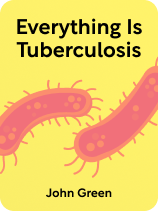

This article is an excerpt from the Shortform book guide to "Everything is Tuberculosis" by John Green. Shortform has the world's best summaries and analyses of books you should be reading.
Like this article? Sign up for a free trial here.
How has tuberculosis shaped human history? Why is tuberculosis—a completely curable disease—still killing over 1.6 million people annually?
Best-selling novelist and YouTube educator John Green’s Everything Is Tuberculosis confronts this troubling paradox, revealing how social inequality, stigma, and systemic failures allow a preventable tragedy to continue. After meeting a teenage TB patient in Sierra Leone, Green embarked on a mission to understand and combat humanity’s deadliest infectious disease.
Read more in our overview of Everything Is Tuberculosis.
Featured image via Gage Skidmore
Overview of Everything Is Tuberculosis
In Everything Is Tuberculosis, John Green tackles an urgent yet often overlooked global health crisis: tuberculosis (TB). Despite being both preventable and curable, TB kills more people—over 1.6 million annually—than any other infectious disease worldwide, temporarily surpassed only by Covid-19 at the height of the pandemic. The book’s urgency stems from a troubling paradox: We have known how to cure tuberculosis for decades, yet millions continue to suffer and die from it. This disconnect reveals inequities in our global health systems and represents what Green calls a moral failure of humanity.
Green is best known for his young adult novels like The Fault in Our Stars and his YouTube channels. His interest in TB began on a 2019 visit to Sierra Leone, where he met Henry Reider, a teenager with multidrug-resistant tuberculosis. Green thought Henry was about nine years old—the same age as his own son, also named Henry—but was shocked to learn the boy was actually 16; his growth was stunted by TB and malnutrition. Henry couldn’t access medication because it was too expensive. Fortunately, he recovered, went on to attend university, launched a YouTube channel, and still keeps in touch with Green’s family. For Green, this connection turned TB from an abstract global health crisis to a reality with tangible human costs.
Our guide follows Green’s exploration of TB in three sections: First, we examine what TB is, tracing its scientific understanding and historical impact. Second, we investigate why TB persists despite being curable, exploring social determinants, stigma, healthcare barriers, and the legacy of racialized medicine. Finally, we outline Green’s vision for how we can end TB through medical innovations, social interventions, policy changes, and advocacy. Throughout, we also connect Green’s analysis to other fields—from ecological systems thinking to architectural history to social justice movements—providing other perspectives on how we might reimagine our response to this ancient disease.
What Is Tuberculosis?
Tuberculosis, or TB, is an airborne disease that has plagued humanity for thousands of years. Caused by the bacteria Mycobacterium tuberculosis, it primarily attacks the lungs but can invade other parts of the body too. Green explains how TB spreads: When someone with active TB coughs, sneezes, or even just talks, they release microscopic droplets containing the bacteria into the air. Anyone who breathes in these particles can become infected. Once the bacteria enter your body, Green explains, one of two things happens:
1) Latent TB: Your immune system walls off the bacteria, keeping them dormant. You won’t have symptoms and can’t spread TB to others. But here’s the catch: Those bacteria are playing the long game. Green notes they can activate years later if your immune system weakens. That’s why doctors often recommend preventive antibiotics for people with latent TB, especially those with compromised immunity.
2) Active TB: The bacteria multiply and cause illness. You might develop a persistent cough (sometimes bringing up blood), fever, night sweats, and dramatic weight loss. Even after you successfully treat an active TB infection, you still have an elevated risk of developing active TB again, either as a relapse of your existing infection or as a new infection.
What makes TB’s continued prevalence such an urgent problem to address, Green argues, is that we can prevent and cure it. The standard treatment combines four antibiotics—rifampicin, isoniazid, pyrazinamide, and ethambutol (a regimen doctors call “RIPE”)—taken over several months. Complete the full course, and you can usually cure TB, even in its active form.
Tuberculosis Has Been With Us for Thousands of Years
TB has been shaping human societies since ancient times. Before modern medicine identified its cause, people developed all sorts of theories about where it came from. Green explains that some saw it as divine punishment. Others blamed heredity or “bad air.” Many considered it an inevitable consequence of city living. People called it “consumption” because the disease seemed to consume victims from within, wasting them away to skeletal figures. The Industrial Revolution created perfect conditions for TB to flourish: Crowded tenements and factory floors with poor ventilation became hotbeds for TB transmission.
Everything changed (or should have) in 1882, when scientist Robert Koch identified Mycobacterium tuberculosis as the bacterial cause of the disease. Green describes this discovery as revolutionary. Suddenly, TB wasn’t some mysterious curse but a specific infection that scientists could fight. Despite this breakthrough, effective treatments remained elusive for decades. TB patients were sent to sanatoriums, facilities usually built in mountains or the countryside where they could rest, eat well, and breathe fresh air. While these institutions helped some patients recover, Green notes they primarily served to isolate the sick from the healthy rather than provide a reliable cure for the disease.
Green explains that the true game-changer for treating—and in theory, eradicating—TB arrived in the mid-20th century: antibiotics. When doctors first used streptomycin against TB in 1944, it marked the beginning of a new era. For the first time in human history, TB became consistently curable. Green emphasizes that this makes today’s TB crisis all the more notable. We’ve had the tools to cure this disease for generations, yet millions still die from it annually.
Tuberculosis Remains the Leading Fatal Infectious Disease
According to World Health Organization data from 2021, about 10.6 million people fell ill with TB worldwide, and 1.6 million died. This makes TB the world’s deadliest infectious disease (briefly surpassed only by Covid-19 during the pandemic’s height) and a bigger killer than HIV/AIDS. The geographic patterns of TB’s prevalence reveal striking social inequalities. Green points out that TB has nearly vanished from wealthy countries—the United States sees fewer than 10,000 cases annually, almost all successfully treated.
Meanwhile, the disease remains prevalent in regions with high poverty rates, widespread malnutrition, and limited healthcare. Countries across sub-Saharan Africa, Southeast Asia, and parts of Eastern Europe see the highest numbers of cases. Green explains that this is the fundamental injustice of TB today: The challenge isn’t that we lack the knowledge or tools to fight TB; it’s that those resources aren’t accessible to the people who need them most.
Why Does Tuberculosis Persist Despite Being Curable?
Green identifies four factors that allow TB to persist despite our ability to prevent and treat it: economic and social conditions, stigma against the disease, barriers to healthcare access, and the legacy of racialized medicine. Each plays a critical role in maintaining TB’s deadly global presence.
Factor #1: Economic and Social Conditions
First, at the heart of TB’s persistence are what health experts call “social determinants of health”: the economic and social conditions that shape how people live, work, and age. Green argues that these factors create environments where TB flourishes and limit access to the care needed to cure it.
1) Poverty stands out as TB’s most powerful ally. Green notes that unlike in earlier centuries when TB affected people across all social classes, today the disease disproportionately impacts the poor. Limited financial resources mean less access to nutritious food, adequate housing, and healthcare services—all crucial for TB prevention and treatment.
2) Malnutrition contributes to TB in what Green calls a vicious cycle. Poor nutrition weakens the immune system, which makes people more susceptible to TB infection and more likely to develop the active form of the disease. Once sick, patients often can’t work. This deepens poverty and worsens malnutrition, further compromising their ability to fight the infection.
3) Housing conditions also play a crucial role in TB transmission. The disease thrived during the Industrial Revolution, when rapid urbanization crammed workers into poorly ventilated tenements. Green points out that similar conditions persist in many parts of the world today. In urban slums and overcrowded housing, TB bacteria easily pass in the air from person to person.
4) Education levels significantly impact TB outcomes too. Green explains that limited education affects people’s understanding of disease prevention, recognition of symptoms, and ability to follow treatment regimens. When combined with other social challenges, educational disadvantages further increase vulnerability to TB.
5) Employment status and working conditions also influence TB risk. Green explains that stressful or dangerous work environments compromise overall health, while unemployment constrains the financial resources that people need to access nutrition and healthcare. For many TB patients, the months-long treatment period can lead to lost wages or jobs, pushing them deeper into poverty.
6) Finally, Green explains that social support networks affect TB resilience and recovery. People with strong family and community connections generally experience better health outcomes. Those facing social isolation—often made worse by the stigma that TB carries, as we’ll see in the next section—face additional challenges in their recovery.
Factor #2: Stigma Against Tuberculosis
The second reason TB persists involves a historical paradox: While once romanticized, TB today carries a powerful stigma that prevents people from seeking and completing treatment. Green explains that in 18th- and 19th-century Western society, TB (then called “consumption”) became fashionable as it was associated with artistic sensitivity and passion. The physical effects—pale skin, flushed cheeks, bright eyes, and extreme thinness—aligned with beauty ideals of the period, particularly for women. Some even believed TB enhanced creativity by causing suffering that deepened a person’s artistic vision.
Green explains that the romanticization of the disease emerged partly because TB affected all social classes, including the wealthy and creative. Rather than stigmatize a disease that struck indiscriminately, society transformed it into something meaningful—a cultural coping mechanism for dealing with the widespread suffering that TB caused.
Green says the contrast between the romanticization of TB in the Victorian era and the way the disease is seen today couldn’t be starker. Modern TB carries intense stigma, especially in the communities where it’s most common. This stigma stems from fear of infection, association with poverty, and misconceptions about how the disease spreads. Green identifies several ways this stigma undermines TB control:
1) People delay seeking diagnosis when shame surrounds the disease. Green shares the story of a young woman who told him she wished she had cancer instead of TB to avoid the profound shame her diagnosis brought. This reluctance to acknowledge symptoms allows the disease to progress and spread to others.
2) People don’t adhere to treatment. Patients may hide their condition and avoid taking medication in public. Since TB treatment requires months of daily medication, this social pressure can lead to incomplete treatment and the development of drug-resistant strains.
3) People experience social isolation, compounds suffering. Green describes how Henry, the boy he met in Sierra Leone, was shunned by his extended family after his diagnosis, with some believing he was “cursed.” This rejection removes essential support systems just when patients need them most.
4) Physical illness combined with social rejection has a psychological impact. Depression and anxiety frequently accompany TB diagnosis, complicating recovery and reducing quality of life.
Factor #3: Barriers to Health Care Access
Even when people overcome stigma and seek care, Green says numerous barriers block access to effective TB diagnosis and treatment:
1) Geographic barriers. In remote or underserved areas, healthcare facilities may be distant or completely absent. Green explains that for patients in these regions, reaching appropriate care often requires long, expensive journeys that many can’t afford.
2) Financial barriers. Even when facilities exist nearby, poverty forces impossible choices between paying for TB treatment or meeting basic needs like food and shelter. Without universal healthcare coverage or subsidized TB programs, many patients start but cannot complete the lengthy treatment regimen.
3) Diagnostic limitations. Many healthcare settings in high-burden countries lack modern diagnostic tools, relying instead on less accurate methods that might miss cases or fail to identify drug resistance. This means many patients receive inadequate treatment or none at all.
4) Medication access issues. Patent restrictions, high prices, and regulatory hurdles keep life-saving medications from those who need them most. Green recounts the story of Shreya Tripathi, a 19-year-old Indian TB patient who sued her government for access to bedaquiline, a critical medication for drug-resistant TB. Though she won her case, the medication arrived too late to save her life.
5) Healthcare workforce shortages. Many high-TB-burden countries have too few trained healthcare workers, especially in rural areas. Those working in TB care often face overwhelming caseloads with inadequate resources, compromising their ability to provide comprehensive care and follow-up.
Factor #4: Racialized Medicine
The fourth factor Green identifies is the harmful legacy of racialized medicine—viewing diseases through the lens of race and attributing biological differences based on racial categories. Historically, medical authorities claimed that certain racial groups were inherently more susceptible to TB due to supposed biological weaknesses or moral failings. Green explains how this racialized view diverted attention from the real socioeconomic and environmental factors driving TB transmission. By attributing TB to racial characteristics, medical professionals and policymakers justified neglecting marginalized communities and denying them proper resources.
Green offers an example from Canada and the US, where Indigenous children were forcibly sent to residential schools with overcrowded, poorly ventilated quarters where TB spread rapidly. Rather than addressing these conditions, authorities attributed the high TB rates to an inherent “racial susceptibility” among Indigenous peoples. This racist belief led to deliberate neglect, resulting in staggeringly high mortality rates among these children.
This harmful legacy continues today in more subtle forms, Green argues. It influences which communities receive attention and resources for TB prevention and treatment. He points to disparities in TB rates along racial and ethnic lines in many countries—disparities that reflect social inequities rather than biological differences, yet are sometimes still misinterpreted through a racialized lens. Green contends that overcoming this legacy requires recognizing that TB is fundamentally a disease of poverty and social injustice, not race. Only by addressing the true socioeconomic determinants of TB can we hope to eliminate it as a public health threat.
How Can We End Tuberculosis?
Green outlines a comprehensive approach to ending the TB epidemic, combining medical innovations, social changes, policy adjustments, and individual advocacy. No single strategy will work in isolation—we need action on all fronts.
Medical Approaches: Improve Diagnosis, Treatment, and Prevention
While medicine alone can’t solve the TB crisis, Green highlights several medical advances that could dramatically reduce TB’s toll while we address deeper social issues:
1) Better diagnostic tools. Green describes newer technologies like GeneXpert that can diagnose TB and detect drug resistance in hours, not the weeks required by traditional methods. These tools remain out of reach in many high-burden areas due to cost and infrastructure limitations. Green advocates reduced pricing and versions adapted for resource-limited settings so these life-saving diagnostics can reach those who need them most.
2) Treatment innovations for drug-resistant TB cases. Green spotlights newer medications like bedaquiline that can treat stubborn TB strains that don’t respond to standard antibiotics. He shares how he took on pharmaceutical giant Johnson & Johnson, criticizing their high prices and restrictive patents on bedaquiline. This public pressure campaign succeeded—the company agreed to allow generic manufacturing, slashing the daily treatment cost from $1.50 to $0.50.
3) Preventive therapy. Green explains that treating latent TB infection—before it becomes active disease—is simpler and requires fewer medications for a shorter time. This approach could significantly reduce new TB cases, particularly among high-risk groups. Yet limited resources often restrict these preventive programs to very narrow populations.
4) Vaccine development also remains a critical frontier. The current BCG vaccine provides some protection for children against severe forms of TB but offers limited protection for adults. Green notes that research into more effective vaccines for TB continues, but remains underfunded compared to efforts to develop vaccines for other diseases.
Social Approaches: Address Stigma and Social Determinants of Health
Beyond medical interventions, Green champions social strategies that address TB’s root causes:
1) Public education campaigns to fight stigma and misinformation. Green points to successful programs that involve TB survivors in community education, helping normalize the disease and encourage testing. These campaigns emphasize three key messages: TB is curable, not a moral failing; patients quickly become non-infectious with proper treatment; and support rather than rejection helps recovery.
2) Community engagement to strengthen TB control efforts. Programs that train local community members as health educators and treatment supporters have shown impressive results. This approach builds trust, ensures culturally appropriate messaging, and creates vital support systems for TB patients navigating months of treatment.
3) Tackling poverty and malnutrition. Green highlights programs that combine TB treatment with nutritional support, housing assistance, and income-generation opportunities. These comprehensive approaches recognize that medical treatment alone won’t solve the problem if patients return to the same conditions that made them sick in the first place.
4) Improving housing and ventilation to reduce transmission risk. Simple interventions like adding windows or ventilation systems to buildings can significantly reduce airborne TB transmission. In high-burden areas, Green advocates housing policies that establish minimum ventilation standards and limit overcrowding.
5) Educational support to enhance health literacy and outcomes. General education—particularly for women—correlates strongly with better health outcomes across the board, including TB prevention and treatment success. Green sees removing barriers to education as a long-term TB control strategy with multiple benefits.
Policy Approaches: Healthcare Systems, Funding, and Political Action
Ultimately, Green argues, ending TB requires policy-level changes:
1) Strengthen healthcare systems. Fragmented, underfunded health systems struggle to provide the consistent, long-term care TB patients require. Green advocates for investments in primary healthcare infrastructure, reliable supply chains for TB medications, and improved laboratory capacity in high-burden countries.
2) Reform medication access policies. Green describes his advocacy for the End Tuberculosis Now Act in the United States, which would authorize increased international assistance for TB elimination. He also pushes for reforms to patent systems and pricing practices that keep essential TB medications unaffordable where they’re needed most.
3) Establish sustainable funding mechanisms. Green criticizes how TB control efforts in many countries rely heavily on international donor funding, creating vulnerability to shifting political priorities and funding cuts. He calls for increased domestic funding for TB programs and innovative financing approaches to ensure sustainability.
4) Increase cross-sector collaboration. TB control requires coordination across health, housing, education, and social welfare sectors. Green highlights successful models where governments have established multi-sectoral TB committees with the authority and funding to implement comprehensive strategies.
5) Strengthen global solidarity. Green argues that wealthy nations have compelling reasons to support global TB control efforts. Beyond humanitarian concerns, he notes that in our interconnected world, drug-resistant TB anywhere poses a potential threat everywhere. The tools and knowledge to end TB already exist; what’s lacking is the commitment to deploy them equitably.
Individual and Collective Advocacy
Green concludes with a call for action, both on the individual and community level:
1) Become more aware. Green argues that once we understand TB’s devastating impact and the systems perpetuating it, we have a responsibility to act. He shares how his own learning journey transformed into advocacy and encourages readers to similarly translate knowledge into action.
2) Leverage privilege for change. Green acknowledges his position as a bestselling author and internet personality with millions of followers. He describes how he used this platform to pressure pharmaceutical companies and raise awareness about TB. He encourages readers to identify and use whatever privilege or platform they possess to advocate for those without such access.
3) Use community power to amplify individual voices. Green celebrates the “Nerdfighter” community he and his brother Hank have cultivated, describing how their online followers have raised millions for global health initiatives. He argues that collective action—even from those without traditional forms of power—can create significant change when properly organized and directed.
4) Stay committed. Green emphasizes that addressing TB requires long-term dedication, not just short-term campaigns. He draws parallels to other successful public health initiatives, like smallpox eradication, which succeeded through decades of persistent effort.
Green’s message balances urgency with hope. TB’s persistence represents a failure of our global community, but also an opportunity to demonstrate our capacity for collective action and compassion. Green believes that by sharing what we know, using what influence we have, and joining with others, we can end tuberculosis and create a more just global health system in the process.

———End of Preview———
Like what you just read? Read the rest of the world's best book summary and analysis of John Green's "Everything is Tuberculosis" at Shortform.
Here's what you'll find in our full Everything is Tuberculosis summary:
- Why this curable disease is still killing over 1.6 million people annually
- The different types of TB, how it's spread, and how it affects the body
- A comprehensive approach to ending the TB epidemic






